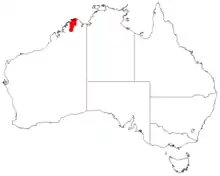Acacia dacrydioides
Acacia dacrydioides is a shrub belonging to the genus Acacia and the subgenus Juliflorae that is endemic to north western Australia.
| Acacia dacrydioides | |
|---|---|
| Scientific classification | |
| Kingdom: | Plantae |
| Clade: | Tracheophytes |
| Clade: | Angiosperms |
| Clade: | Eudicots |
| Clade: | Rosids |
| Order: | Fabales |
| Family: | Fabaceae |
| Clade: | Mimosoideae |
| Genus: | Acacia |
| Species: | A. dacrydioides |
| Binomial name | |
| Acacia dacrydioides | |
 | |
| Occurrence data from AVH | |
Description
The loose shrub typically grows to a height of 1 to 3 metres (3 to 10 ft)[1] and has a spreading arching habit. It has terete villous branchlets that are fawn to red-brown in colour. Like many species of Acacia it has phyllodes instead of true leaves. The evergreen linear shaped phyllodes are 0.6 to 1.3 cm (0.24 to 0.51 in) in length and 0.2 to 0.4 mm (0.0079 to 0.0157 in) that are sparsely villous.[2] It blooms from March to June producing yellow flowers[1] arranged along flower-spikes that are 0.8 to 2.2 cm (0.31 to 0.87 in) in length. Following flowering glabrous seed pods for that resemble a string of beads with dark red to brown ribbed valves form. The pods are 6 to 8 cm (2.4 to 3.1 in) in length and around 5 mm (0.20 in) wide with seeds arranged longitudinally inside.[2]
Distribution
It is native to an area in the Kimberley region of Western Australia where it is found on ridges amongst rocks in areas of sandstone and quartzite.[1] The bulk of the population is found in the King Edward River district around the Kalumburu Mission where it is usually part of mixed woodland communities on ridges or on river banks in deep sand.[2]
See also
References
- "Acacia dacrydioides". FloraBase. Western Australian Government Department of Parks and Wildlife.
- "Acacia dacrydioides". World Wide Wattle. Western Australian Herbarium. Retrieved 30 August 2019.